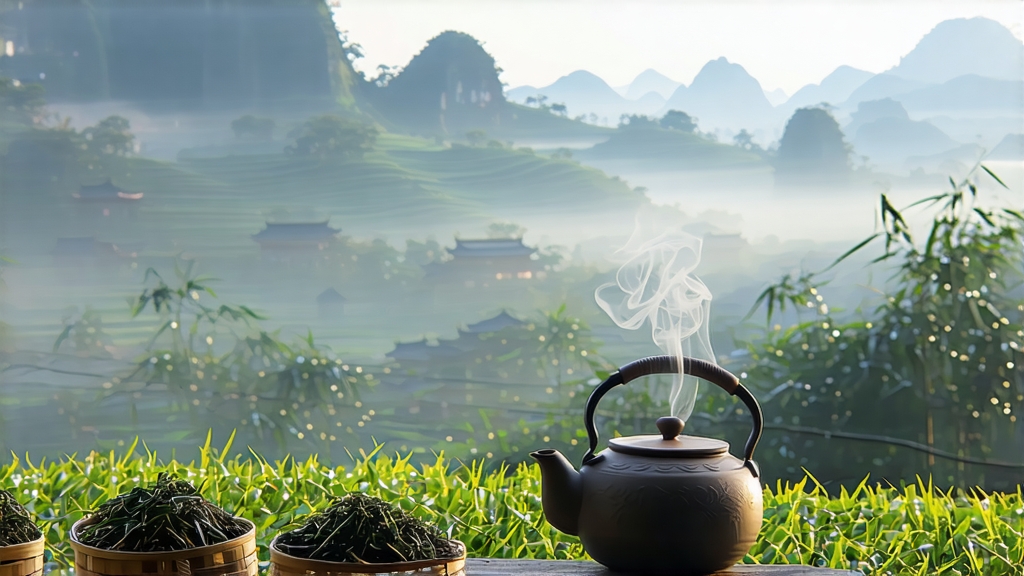
Tucked away in the humid, karst-pocked mountains of southern China’s Guangxi Zhuang Autonomous Region, Liu Bao tea has spent four centuries quietly perfecting the art of microbial alchemy. To most outsiders “dark tea” begins and ends with Yunnan’s Pu-erh, yet Liu Bao is the older, subtler sibling—fermented, pressed, and cellared long before the word “pu-erh” ever appeared on a London menu. This article invites the global tea traveler to discover Liu Bao’s history, craftsmanship, and the sensory code that unlocks its deep, betel-nut sweetness.
-
From Border Trade to World Expo
During the late Ming dynasty (c. 1600) the small county town of Cangwu—today’s Wuzhou—sat on the Xun River, a tributary of the Pearl. Junks carried rice, spices, and pressed wicker-basket tea downriver to Guangzhou and on to Southeast Asia. The tea, packed in 40 kg bamboo baskets, absorbed river humidity and arrived naturally darker, smoother, and suddenly popular with Cantonese coolies and Malayan tin miners who swore it cured dampness and fatigue. By the Qing Qianlong era (1736–95) Liu Bao had earned imperial tribute status; in 1886 a Wuzhou merchant house steamed, pressed, and shipped it to the Colonial and Indian Exhibition in London, where judges praised its “mellow Chinese coffee.” War and revolution interrupted exports, but the 1950s state-run Wuzhou Tea Factory revived production for Hong Kong and Kuala Lumpur dim-sum halls, cementing Liu Bao’s role as the diaspora’s digestif. -
Leaf, Land, and Microbiome
Authentic Liu Bao comes only from the foothills of the Dawu and Liu Bao townships, where red lateritic soil forces the indigenous large-leaf Camellia sinensis var. sinensis to send roots deep for minerals. Spring fog and summer heat create a natural greenhouse; wild yeasts (Cyberlindnera, Pichia) and bacteria (Bacillus, Aspergillus) colonize the leaf surface, the starter culture for later fermentation. Farmers pick one bud plus the third or fourth leaf—older, tougher foliage whose lignin and cellulose will become the banquet for those microbes. -
The Eight-Step Craft
a. Wilting: Fresh leaves are spread 4 cm thick on bamboo trays for 4–6 h, losing 10 % moisture and grassy edge.
b. Kill-green: A 5-minute 200 °C tumble in a heated wok deactivates polyphenol oxidase but leaves surface microbes intact—crucial for Liu Bao.
c. Rolling: Light pressure for 12 min bruises cells without shredding, preparing sugars for microbial consumption.
d. Pile-fermentation (wo dui): The signature step. Leaves are heaped 70 cm high, sprayed with Wuzhou’s mineral-rich river water, covered with wet jute sacks, and left for 25–35 days. Internal temperature climbs to 55 °C; thermophilic bacteria bloom, turning catechins into theaflavins and gallic acid, gifting the tea its amber liquor and camphor-betel nuance.
e. Drying: A wood-fired basket dryer drops moisture to 12 % in three hours, adding a whisper of smoke.
f. Sorting & blending: Masters nose through piles, matching batches to achieve a consistent “Liu Bao fragrance.”
g. Steaming & pressing: 30 seconds of 100 °C steam softens the leaf for hand-pressing into 40 kg bamboo baskets lined with untreated banana leaf. The bamboo breathes, allowing micro-oxygenation for decades.
h. Aging: Baskets are stacked in riverside caves or climate-controlled warehouses at 28 °C and 80 % humidity. Every two years the tea is resteamed and repacked, flattening acidity and deepening sweetness. Top lots rest 30 years, developing medicinal ginseng and date notes. -
The Three Faces of Liu Bao
Traditional Basket (sheng cha): Fermented once, then aged. Young versions taste of raw cacao and damp bark; after 15 years they reveal dried longan, sandalwood, and a cooling menthol finish.
Cooked Loose (shu